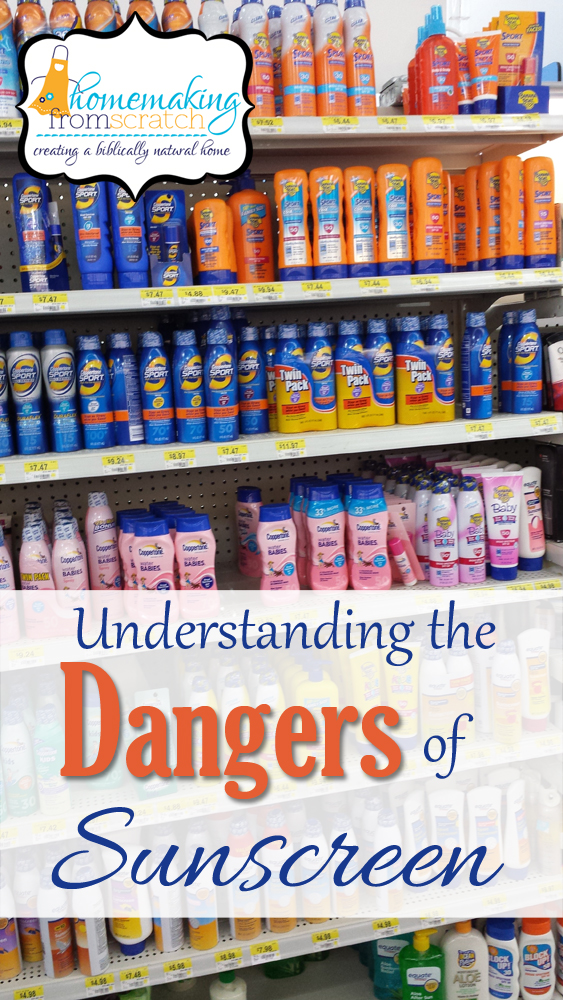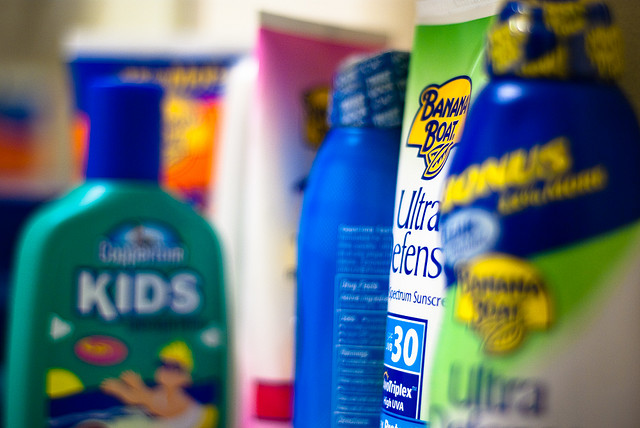The Dangers of Sunscreen: What You May Not Know
Sunscreen was created nearly 100 years ago to block our skin from absorbing harmful ultraviolet (UV) rays. Coppertone was introduced to the market in 1944 as the first sunscreen marketed to the public widely (source). Now, American’s hardly leave the house without slathering on the stuff! But is this practice really safe? Are we really protecting our skin from the sun or further harming our bodies from the chemicals?

Skin cancer is on the rise! You don’t want to get it? Slather yourself with sunscreen every 2 hours. In fact, that’s not enough protection. You need to wear sunscreen everyday of the year because even on non-sunny days, UV rays still come through the clouds. You might as well just wear a suit of suncreen at all times!
That is the typical stance on sunscreen today. And yet, traditional sunscreen has been shown to be toxic and incredibly unhealthy!
So What’s The Deal With Sunscreen?
According to the Skin Cancer Foundation:
From 1970 to 2009, the incidence of melanoma increased by 800 percent among young women and 400 percent among young men.”
I think we need to ask ourselves – why have we seen such a huge rise in skin cancer in the past few decades? Are people in the sun more than in centuries past? I tend to not think so since the days of plowing the fields under the hot sun have been largely exchanged for days sitting in an air conditioned office.
I wonder if our modern lack of modesty has something to do with it? Since 1970, young women’s bathing suits have become smaller and smaller, now hardly covering a thing! Has our culture fallen further into vain attempts at beauty by sunbathing for hours in the hot sun wearing nearly nothing contributed to the rise in skin cancer by 800%? Maybe. But modern medicine’s magical lotion, sunscreen, is falling short on protecting American’s from skin cancer.

The Largest Organ of Our Body
Anything that we lather on our skin {lotions, perfumes, deoderant, makeup, ect} is quickly absorbed into our blood stream. As we all know from elementary school, the skin is the body’s largest organ! What does this mean?
Chemicals can be absorbed through skin and into the blood stream causing toxic effects. The chemicals may also cause reactions on the skin surface. Some individuals may be particularly sensitive to a compound or a plant and others may experience little or no effects from contact.” ~ EXTOXNET {Cornell University, Oregon State University, the University of Idaho, and the University of California at Davis}
This really makes me think twice as most modern “beauty” and “skin care” products contain dozens of toxic chemicals including “carcinogens, reproductive toxins, endocrine disruptors, phthalates, nitrosamines, lead, heavy metals and formaldehydes” {source}. Some studies estimate that up to 60% of what we put on our skin gets absorbed directly into our blood stream. According to one study, “the underarms and genitalia showed up to a 100% absorption” (Kasting, 2005).
According to OSHA, in reference to chemicals and toxins in the workplace,
Most chemicals are readily absorbed through the skin and can cause other health effects and/or contribute to the dose absorbed by inhalation of the chemical from the air. Many studies indicate that absorption of chemicals through the skin can occur without being noticed by the worker. In many cases, skin is a more significant route of exposure than the lung.”
What is so Harmful About Sunscreen?
Not everything we put on our skin is bad. For example we readily take hot baths and apply aloe vera to our skin…and that isn’t toxic! It all depends on what you are lathering on your skin. Many natural products are safe to use such as pure aloe vera to your skin or beeswax for your lips. But most sunscreens on the market are not safe and the toxins can be absorbed easily into your bloodstream and your body. Even with the FDA cracking down on sunscreen, there is more you need to know!
Vitamin A {AKA retinyl palmitate and retinol}
Retinal is a common ingredient in sunscreens and makeup and takes on an anti-aging property. However, according to the Environmental Working Group,
It is used in regular makeup as an anti-aging ingredient but, perversely, has been shown to hasten the development of skin tumors and lesions on sun-exposed skin. Data on the potential skin cancer risk of retinyl palmitate have been public since 2010, but most sunscreen makers have not removed this chemical from their products.”
According to CNN, “Government-funded studies have found that this particular type of vitamin A may increase risk of skin cancer when used on sun-exposed skin. However, these reports have been in mice and evidence has been inconclusive for humans.” Vitamin A is not an essential ingredient in sunscreen so until the studies are conclusive, I will not be using sunscreen with this ingredient! Read more about the problem with Vitamin A and learn more about Vitamin A studies.

Oxybenzone
Oxybenzone should be avoided at all costs as studies have linked it to skin cancer and as a hormone disruptor. According to EWG,
“It soaks through skin, triggers allergic skin reactions in sensitive individuals and may be a hormone disruptor. The FDA has yet to review any data on the potential toxicity of oxybenzone and other chemical sunscreen ingredients, despite evidence they can mimic hormones (Krause 2012) and have been detected in urine and breast milk samples (Schlumpf 2010, Calafat 2008).”
While the FDA insists that it’s a safe ingredient, the bottom line is, it has not been effectively tested. The studies that have been done have largely been ignored. What we need is further testing…or simply avoid this potentially toxic ingredient.
Finding Safe Alternatives
Vitamin A and Oxybenzone are only two of dozens of chemicals that are in modern sunscreens. Personally I am leery of so many chemicals {especially so many that are shown to be toxic} that are lathered on my skin. It’s a breath of fresh air to see natural sun screen alternatives with ingredients you can actually pronounce and know what they are as opposed to the long list of ingredients in normal sunscreen.
So the next time you walk into Walmart to pick up a bottle of sunscreen – please think twice! I know it can seem overwhelming but there are safe and natural alternatives! This month we will dive deeper into all things sunscreen and we will extensively cover natural and safe alternatives for fun in the sun but until then, review this list of things to void in the sun and safe sunscreens to use! And here are 9 surprising facts about the sun.
Sources for further study:
- http://www.doctoroz.com/videos/your-sunscreen-might-be-poisoning-you
- http://extoxnet.orst.edu/tibs/cutaneou.htm
- http://www.we-be-healthy.com/skincare/
- http://www.cnn.com/2012/05/16/health/sunscreen-report
- http://www.ewg.org/2013sunscreen/the-problem-with-vitamin-a/
- http://www.ewg.org/2013sunscreen/9-surprising-facts-about-sunscreen/
- http://www.ewg.org/2013sunscreen/what-not-to-bring-on-vacation/
- http://www.ewg.org/2013sunscreen/best-sunscreens/best-beach-sport-sunscreens/
What do you think about sunscreen? What does your family use?
